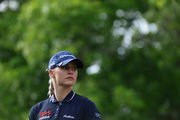
Imago
Sep 21, 2024; Carrolton, Texas, USA; Bryson DeChambeau of the Crushers GC walks down the first fairway during the LIV Golf Dallas Team Championship Semifinals at Maridoe Golf Club. Mandatory Credit: Raymond Carlin III-Imagn Images

Imago
Sep 21, 2024; Carrolton, Texas, USA; Bryson DeChambeau of the Crushers GC walks down the first fairway during the LIV Golf Dallas Team Championship Semifinals at Maridoe Golf Club. Mandatory Credit: Raymond Carlin III-Imagn Images
There’s always been a certain expectation with Oakmont—that it’s going to be brutal, that the rough will be unforgiving, and that only the toughest will survive. But this time, it feels a little different. Maybe it’s the weather, maybe it’s the setup, or maybe the course has just tipped a little too far into punishing territory. Whatever it is, players aren’t just brushing it off anymore. The usual quiet acceptance has turned into open frustration, and heading into the U.S. Open, those complaints are starting to stack up.
Watch What’s Trending Now!
“Obviously, Oakmont is one of the hardest places in the world. It’s going to be hard to simulate that,” said Ludvig Aberg, reflecting on Oakmont Country Club. The Swedish golfer has been preparing for the 2025 U.S. Open, noting that Oakmont demands a lot of patience and precise execution of golf shots. Aberg’s thoughts on the course were echoed by TikTok superstar Ben Griffin.
He recently showcased the intense rough at Oakmont, saying, “You’re gonna have to hit fairways this week.” Griffin’s post highlighted the challenges players will face, with some fans debating whether the rough is too extreme, while others appreciate the added difficulty it brings to the game. The roughs were such a problem that top LIV golfers had to adapt, and defending champion Bryson DeChambeau’s experience was a prime example.
ADVERTISEMENT
DeChambeau described Oakmont’s conditions as “the hardest this golf course could ever play right now,” praising the course’s notorious rough, lightning-fast greens, and plethora of bunkers. At the par-3 6th hole, DeChambeau hit his tee shot over the green into the rough, where his ball was hidden in the thick grass, prompting him to say, “That is cooked beyond belief… That’s burnt to a crisp.” Well, it seems the officials have finally listened to the golfers.
In response to mounting complaints, U.S. Open officials have mobilized what looked like an entire army of greenkeepers armed with push‑style lawnmowers—at least 20 to 30 staffers—meticulously working through the five‑inch rough to “stand the grass up” and “cut it back,” per the latest post by NUCLR Golf on X. This wasn’t a drastic trimming, but rather a surgical operation: they’re using customized mowers that cut uniformly while keeping the grass blades vertical—precisely so balls will sink deep into the tangled roots, not sit on top ready to be struck. On Monday alone, workers pushed the rough down to about 4¾ inches, and additional passes are planned before the weekend.
⛳️🚜 The Oakmont maintenance crew is out in full force today #USOpen
— NUCLR GOLF (@NUCLRGOLF) June 9, 2025
ADVERTISEMENT
But even after all that, players like Jhonattan Vegas still labeled it “unplayable,” with visuals showing golf balls disappearing entirely when dropped from knee height. In short, officials moved quickly to assert control; yet, the undercurrent remains: Oakmont’s rough is still punishing, and players know the margin for error will be razor-thin.
Naturally, the move sparked a wave of reactions online, with fans quick to weigh in on whether the adjustment was justified or just another case of the USGA softening the challenge.
ADVERTISEMENT
Top Stories
Pro Suffers Disqualification at PGA Tour Q-School After Several Players Withdrew Abruptly

2025 Vic PGA Championship: Prize Money, Winner’s Payout & More Explored

Brooks Koepka Takes up New Role Amid LIV Golf Exit Rumors Reaching Boiling Point

LIV Golf to Cut Ties With Veteran Pro After His PGA Tour Return Intentions Became Public

Charley Hull Opens Up on Traumatic Divorce from Ex-Husband for the First Time Ever

Netizens find the Oakmont move to be ‘insane’
Starting strong with what one fan wrote, “This is insane 😂,” while the other said, “All of that leftover thatch must make the course ten times more annoying for the pros as well. Good god.” Well, the ‘removal of rough’ has always been a controversial topic in the world of golf, with proponents on both sides presenting compelling arguments.
On one hand, eliminating or reducing rough would make the game more accessible and enjoyable for a broader range of players, including beginners and less experienced golfers. Additionally, it would make shots easier to play, as players would be less likely to get their balls caught in thick grass, and that is exactly why the rough is an integral part of the game’s challenge and strategy, requiring players to employ skill and precision to navigate it successfully. It’s also a key feature in professional tournaments, testing the abilities of top golfers, and contributes to the natural beauty and historical significance of golf courses.
ADVERTISEMENT
One fan wrote, “This isn’t real golf,” and that is something one PGA Tour pro agrees with. Jordan Spieth believes Oakmont Country Club embodies “pure golf” with its challenging layout, saying, “You hit a good shot, you get rewarded for it here. And if you don’t, you’re in big trouble.” He notes that the penal rough and rapid greens will test players’ skills, but it’s not unfair, adding that “it magnifies once you make a mistake if you don’t play the right shot.” Spieth emphasizes that the biggest challenge this week will be “swallowing pride” and accepting bogeys when they come, as “anything more will hurt.”
One fan said, “This is awesome👀,” while the other said, “This is so amazing.” Well, if you also agree with these comments, many may not agree with you, and certainly not the USGA itself. According to the USGA, “for most golf courses, there is no need to have a 5- to 6-foot-wide strip of marginally lower rough surrounding each fairway,” as this feature, known as intermediate rough, was developed for professional tournaments and often requires significant resources and specialized equipment. Eliminating it can help courses reallocate labor and resources to areas with a greater impact on playability.
So, what are your thoughts on the matter? Let us know in the comment section below!
ADVERTISEMENT
ADVERTISEMENT
ADVERTISEMENT
ADVERTISEMENT

